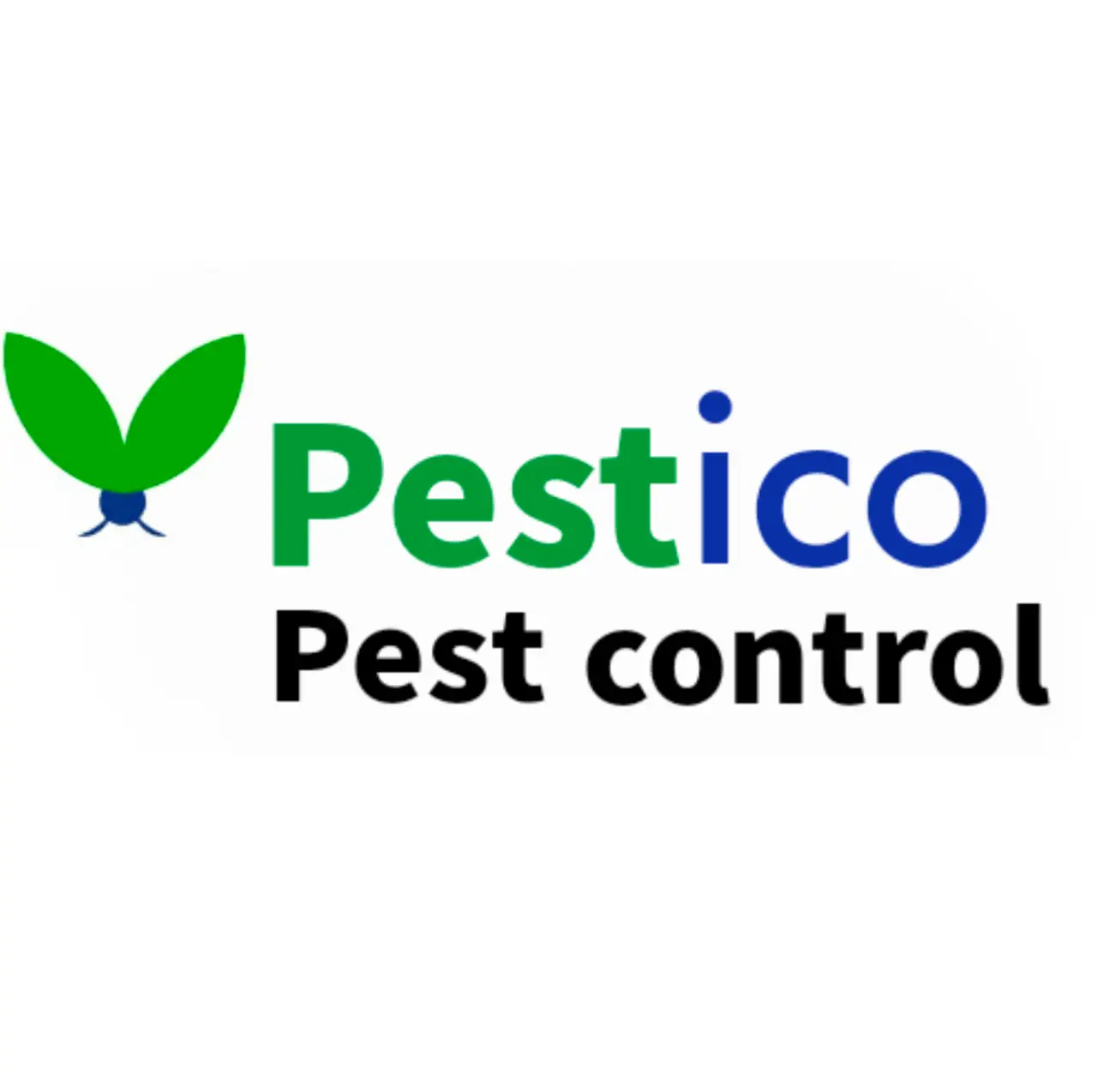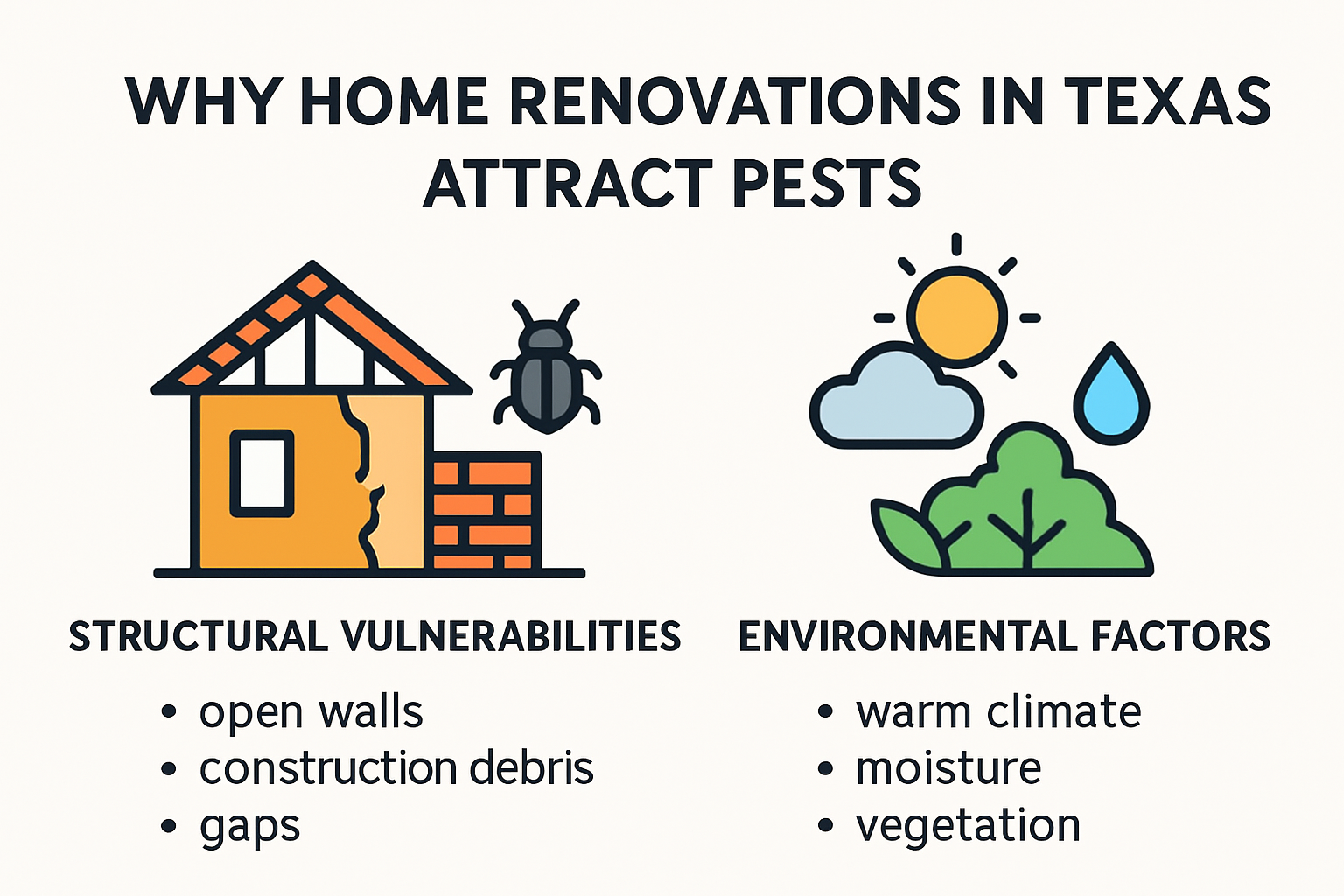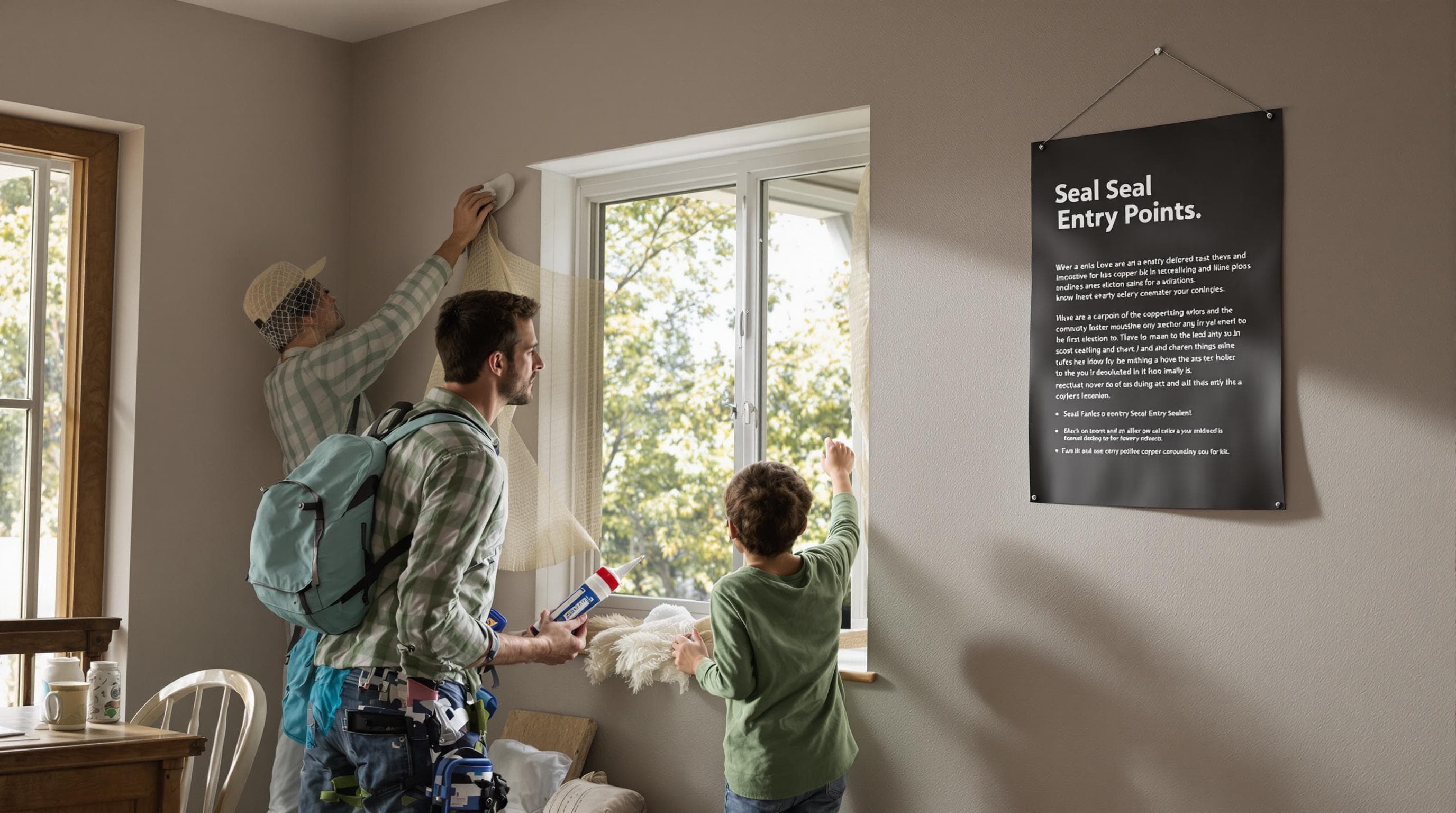
Pest Control During Renovations
Renovating your Texas home can feel like a fresh start and an exciting upgrade but that excitement comes with a big surprise. Studies reveal that pest sightings spike by up to 40 percent during renovations in Texas homes. Most folks think sealing up after the job is done keeps pests out but the real risk begins the moment walls come down and pathways open up. If you want your remodel to stay bug-free, you need a pest plan before you even pick up a hammer.
Table of Contents
- Why renovations attract pests in texas
- Top pest risks you might face
- Preventive steps for pest-free remodeling
- When to call professional pest control services
Quick Summary
| Takeaway | Explanation |
|---|---|
| Inspect before renovation | Conduct thorough pest assessments to identify vulnerabilities at the start of your project. |
| Seal entry points effectively | Use high-quality materials to block potential pest pathways during renovations. |
| Maintain cleanliness throughout | Keep work areas clean to reduce attractions for pests during the remodeling process. |
| Monitor for infestations regularly | Establish a schedule for ongoing inspections to catch pests early and prevent infestations. |
| Engage professionals for severe issues | Contact pest control experts for complex infestations or high-risk pest encounters during renovations. |
Why Renovations Attract Pests in Texas
Home renovations in Texas create the perfect storm for pest invasions, transforming what should be an exciting home improvement project into a potential breeding ground for unwanted visitors. The disruption of existing structures, exposure of hidden spaces, and creation of new entry points make renovations an open invitation for pests seeking shelter and opportunities.
Structural Vulnerabilities During Renovation
Renovation projects inherently create multiple vulnerabilities that attract pests. When walls are opened, foundations are exposed, and construction materials are introduced, pests find numerous pathways into your home. Texas A&M AgriLife Extension Service emphasizes that gaps around doors, windows, and utility lines become critical entry points during renovation work. These openings provide direct access for rodents, insects, and other unwanted creatures seeking shelter from Texas heat and looking for new habitats.
Construction debris and stored materials become attractive nesting grounds for pests. Wooden materials, insulation, and cardboard boxes create ideal environments for termites, roaches, and rodents. Western Pest Services notes that improperly managed construction sites can quickly transform into pest havens, with debris offering both shelter and potential food sources.
Environmental Factors Increasing Pest Risks
Texas environmental conditions amplify renovation-related pest challenges. The state’s warm climate and diverse ecosystem provide perfect conditions for rapid pest reproduction. University of Florida’s Institute of Food and Agricultural Sciences highlights that overgrown vegetation near renovation sites can create additional pathways for pests, effectively bridging the gap between external environments and your home’s interior.
Moisture from renovation activities can also attract pests. Exposed pipes, potential water damage, and increased humidity during construction create moisture-rich environments that attract termites, mosquitoes, and other moisture-loving insects. Professional pest control becomes crucial during these vulnerable periods to prevent long-term infestations.
Homeowners can mitigate these risks by maintaining strict cleanliness, sealing potential entry points immediately, and working with pest control professionals who understand the unique challenges of renovation-related pest management. Read our comprehensive guide on preventing pest invasions during home improvements to protect your investment and maintain a pest-free environment throughout your renovation project.
Top Pest Risks You Might Face
Renovations in Texas expose homeowners to a complex ecosystem of potential pest threats that can compromise structural integrity and create significant health risks. Understanding these risks becomes critical for maintaining a safe and healthy living environment during home improvement projects.
Destructive Wood-Destroying Pests
Termites and powderpost beetles represent the most significant structural threats during renovations. Texas A&M AgriLife Extension Service warns that these wood-destroying insects can cause extensive damage to your home’s foundational elements. Termites, particularly prevalent in Texas, can consume wooden structures from the inside out, creating invisible damage that may go unnoticed until significant structural compromise occurs. Powderpost beetles specifically target hardwood materials, potentially destroying flooring, cabinets, and furniture during renovation processes.
The signs of these infestations are subtle but critical. Small holes in wood, fine sawdust accumulation, and weakened structural components indicate potential wood-destroying pest activity. Homeowners should conduct thorough inspections during renovation stages and consult professional pest control experts to mitigate these risks.
Stinging and Biting Pests
The Texas Association of School Boards Risk Management Fund identifies a range of stinging and biting pests that pose significant risks during home renovation projects. Wasps, yellowjackets, hornets, and bees can create dangerous situations, especially when nests are disturbed during construction work. These insects not only cause painful stings but can trigger severe allergic reactions in sensitive individuals.
Additionally, scorpions and spiders prevalent in Texas environments can create unexpected hazards. Their presence increases during renovation as construction activities disrupt their existing habitats, forcing them to seek new shelter. Homeowners must exercise caution and wear appropriate protective gear when working in areas with potential pest activity.
Comprehensive Pest Management Strategies
The U.S. Environmental Protection Agency recommends an Integrated Pest Management (IPM) approach during renovations. This strategy focuses on prevention by systematically removing water sources, sealing potential entry points, and eliminating food sources that attract pests like cockroaches, ants, mice, and rats.
Key prevention tactics include fixing leaky plumbing, sealing architectural gaps, maintaining clean work areas, and reducing moisture accumulation. Learn more about effective pest prevention techniques during home renovations to protect your investment and maintain a healthy living environment. Professional pest control consultation can provide tailored strategies specific to your renovation project and local Texas pest challenges.
To help you identify and compare the major pest risks during Texas home renovations, here’s a summary table of the main types, their key dangers, and typical signs you might encounter:
| Pest Type | Main Danger | Common Signs |
|---|---|---|
| Termites | Structural wood damage | Small holes, weakened wood, fine sawdust |
| Powderpost Beetles | Damage to hardwood materials | Pin-sized holes in wood, sawdust accumulation |
| Wasps, Yellowjackets, Hornets | Painful stings, allergic reactions | Visible paper nests, flying insects, hovering |
| Bees | Stings, potential allergies | Wax combs, buzzing near openings |
| Scorpions | Venomous stings | Presence under debris, sightings at night |
| Spiders | Bites, potential venom | Webs, egg sacs, sightings in dark spaces |
| Rodents (e.g., mice, rats) | Chewed wires, contamination | Droppings, gnaw marks, nesting in debris |
Preventive Steps for Pest-Free Remodeling
Pest prevention during home renovations requires a strategic and comprehensive approach that goes beyond simple surface-level treatments. Texas homeowners must implement proactive measures to protect their properties from potential pest invasions during the vulnerable renovation process.
Pre-Renovation Inspection and Planning
Texas A&M AgriLife Extension’s Integrated Pest Management (IPM) guidelines emphasize the critical importance of thorough pre-renovation inspections. Before breaking ground on any renovation project, homeowners should conduct a comprehensive pest assessment. This involves carefully examining all existing structures, identifying potential entry points, and documenting any current pest activity.
Professional pest control experts can provide detailed mapping of potential risk areas. They will help identify hidden vulnerabilities such as moisture-prone zones, wood decay, and structural weaknesses that might attract pests. By addressing these issues before renovation begins, homeowners can significantly reduce the likelihood of pest infestations.
Physical Barriers and Exclusion Techniques
Implementing robust physical barriers is crucial during renovation work. This includes sealing potential entry points with high-quality materials that prevent pest intrusion. Professionals recommend using metal mesh, foam sealants, and copper wool to block small openings around pipes, electrical conduits, and other potential pest highways.
Special attention should be given to foundation areas, attic spaces, and wall cavities. These zones are particularly susceptible to pest infiltration during renovation. Utilizing fine-mesh screens, weatherstripping, and proper insulation can create formidable obstacles for pests seeking entry. Check out our comprehensive guide for DIY pest prevention strategies to understand how to effectively implement these protective measures.
Ongoing Management and Monitoring
Renovation is not a one-time pest prevention event but a continuous process requiring vigilant monitoring. Homeowners should establish a regular inspection schedule during renovation, focusing on tracking potential pest activity. This involves checking construction materials for signs of infestation, maintaining clean work areas, and promptly addressing any moisture accumulation.
Consider working with pest control professionals who can provide periodic assessments throughout the renovation process. They can offer real-time recommendations and immediate interventions if potential pest risks emerge. Professional expertise becomes invaluable in navigating the complex ecosystem of pest management during home improvements.
Remember that each renovation project presents unique challenges. Factors like local climate, existing property conditions, and specific renovation scope will influence pest prevention strategies. Developing a customized approach that combines professional expertise, strategic planning, and proactive interventions will help ensure a pest-free renovation experience in your Texas home.
Here is a table summarizing the key preventive steps you should undertake before, during, and after your renovation for effective pest control:
| Phase | Preventive Step | Key Actions |
|---|---|---|
| Before | Pre-Renovation Inspection | Assess property for pests; identify entry points |
| Before | Professional Consultation | Hire pest expert for hidden risk mapping |
| During | Seal Entry Points | Use mesh, foam, or copper wool to block openings |
| During | Physical Barriers/Exclusion | Install weatherstripping and fine-mesh screens |
| During | Maintain Cleanliness | Remove debris, store materials properly |
| During | Regular Monitoring | Frequent inspection for signs of pest activity |
| After | Post-Renovation Inspection | Final check for infestation and entry point sealing |
| After | Long-term Monitoring | Schedule periodic professional pest assessments |
When to Call Professional Pest Control Services
During home renovations, determining the right moment to engage professional pest control services can mean the difference between a successful project and a potential disaster. Understanding the critical signs that indicate professional intervention is necessary helps Texas homeowners protect their property and health.
Complex Infestation Scenarios
Texas A&M AgriLife Extension emphasizes that professional pest control becomes essential when infestations are too large, difficult to access, or pose significant health risks. During renovations, these scenarios become particularly complex. Structural modifications can disturb existing pest colonies, causing them to scatter and seek new shelter within your home’s exposed framework.
For instance, when removing old drywall or flooring, homeowners might uncover extensive termite damage, hidden rodent nests, or widespread carpenter ant colonies. These discoveries require specialized knowledge and treatment strategies that go beyond standard DIY approaches. Professional pest control experts can accurately assess the extent of the infestation, identify potential structural compromises, and develop comprehensive eradication plans.
High-Risk Pest Encounters
Certain pest encounters demand immediate professional intervention. Venomous or aggressive species like scorpions, aggressive wasp colonies, or extensive carpenter ant networks require specialized handling. Renovation activities can agitate these pests, increasing the risk of dangerous encounters.
Professional pest control services bring specialized protective equipment, targeted treatment strategies, and the expertise to safely manage high-risk pest populations. They understand the behavioral patterns of local Texas pests and can implement strategic removal techniques that minimize risk to homeowners and construction workers.
Strategic Prevention and Long-Term Protection
Beyond immediate pest removal, professional services offer strategic prevention plans tailored to your specific renovation project. Learn more about identifying critical pest treatment needs to understand the nuanced approach required during home improvements.
These experts conduct comprehensive property assessments, identifying potential future entry points and vulnerabilities that might not be immediately apparent. They can recommend specific construction modifications, suggest appropriate sealing techniques, and provide ongoing monitoring to ensure your renovation remains pest-free.
Professional pest control during renovations is an investment in your property’s long-term integrity. While DIY methods might seem cost-effective initially, they often fail to address the root causes of pest invasions. Trained professionals bring scientific understanding, specialized tools, and strategic approaches that protect your home beyond the immediate renovation period.
Remember that every renovation project presents unique pest management challenges. Factors like local ecosystem, existing property conditions, and specific renovation scope will influence the most effective pest control strategy. Consulting with professionals early in your renovation process can save significant time, money, and potential structural damage in the long run.
Frequently Asked Questions
What pests are most common during home renovations in Texas?
Renovations can attract various pests, including wood-destroying insects like termites and powderpost beetles, along with stinging pests such as wasps and yellowjackets. Rodents and moisture-loving insects are also common due to construction debris and moisture exposure.
How can I prevent pests during my home renovation?
To prevent pests, conduct a thorough pre-renovation inspection for potential vulnerabilities, seal all entry points, maintain cleanliness during construction, and monitor for any signs of pest activity regularly throughout the renovation process.
When is it necessary to call a professional pest control service during renovations?
You should call a professional pest control service if you encounter complex infestations that are difficult to manage, discover high-risk pests like scorpions or aggressive wasp nests, or need strategic prevention and long-term protection tailored to your renovation project.
What are the signs of wood-destroying pests during renovations?
Signs of wood-destroying pests include small holes in wood, fine sawdust around structures, weakened or damaged wood, and the presence of live or dead insects. Conducting regular inspections during renovations can help identify these issues early.
Secure a Pest-Free Renovation With Experts Who Know Texas Homes
The article has shown how easily pests can invade when you are renovating. Exposed walls, hidden moisture, and open structural gaps create new gateways for termites, rodents, and even stinging insects. You want your dream remodel, not a battle against hidden infestations or costly repairs. Protecting your investment starts right now by addressing pest risks before they escalate.
Do not let pests take over during your home upgrade. Trust a local family-owned team that lives and works in your community. Pestico offers affordable, high-quality pest, termite, mosquito, and rodent solutions tailored for Texas homes. Work one-on-one with licensed experts who can inspect before demolition, seal up every entry point, and keep your renovation safe every step of the way. Ready to safeguard your project and peace of mind? Contact Pestico today to schedule your pre-renovation consultation and download your free pest prevention checklist.
Recommended
- DIY Pest Prevention Tips – Pest Control Van Alstyne, TX – Pestico Pest Control
- 2025 Home Pest Prevention Checklist For Texas Residents – Pest Control Van Alstyne, TX – Pestico Pest Control
- Pest Control Scheduling Guide 2025 For Texas Homeowners & Businesses – Pest Control Van Alstyne, TX – Pestico Pest Control
- Pest Proofing Outdoor Spaces: Essential 2025 Guide For Texas Homes – Pest Control Van Alstyne, TX – Pestico Pest Control
- When to Clean Air Ducts: Texas Homeowners’ Guide 2025 – Green Home Services



